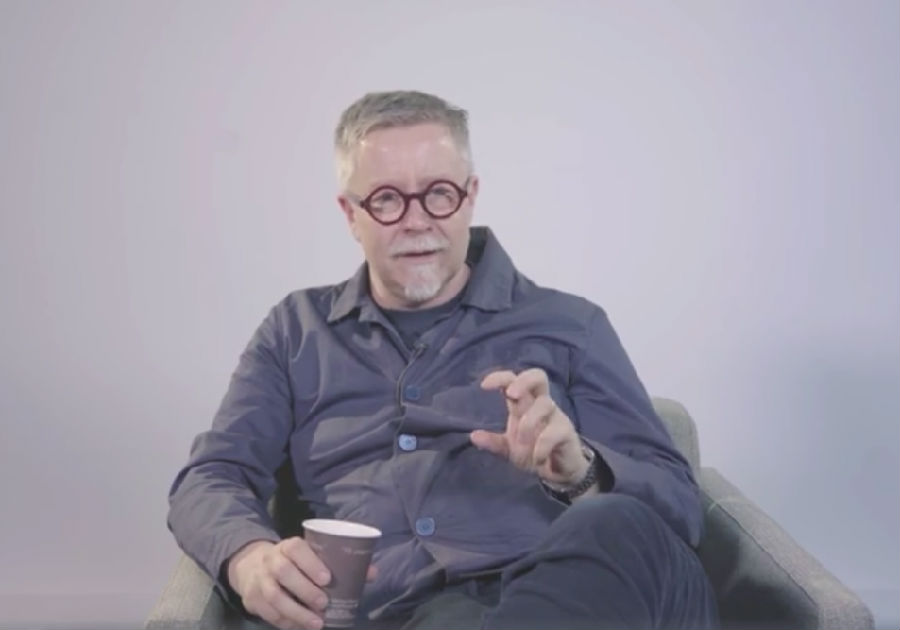This is the first Apple computer mouse.
这是第一代苹果电脑的鼠标
It came with Apple’s ten thousand dollar Lisa computer,
作为苹果价值一万美元的Lisa电脑的配件
and it was designed by a product design consulting firm
是由一个设计咨询公司设计的
that would eventually become known as IDEO.
这个公司就是后来的IDEO
The assignment was straightforward:
这个项目很明了
they had to take the computer mouse —
他们要把电脑鼠标——
a 400-dollar device at the time —
那个时候还是一个价值400美金的设备——
and bring it down to under 35 bucks,
的成本降到35美金,
make it mass-producible, and reliable.
方便大批量生产,同时要保证质量可靠
And above all, it needed to be simple.
最重要的是,这个鼠标要简单好用
We control these so by pointing to these images on the screen with this unique item called a mouse.
我们把这个叫作“鼠标”的东西指向屏幕上的这些图像来控制这些图像
Fast forward about thirty years, and IDEO doesn’t really create products anymore.
接下来的30年很快就过去了,而IDEO也没再做出什么实质性的产品
They’ve transitioned to designing networks and experiences —
他们已经转做网络设计和体验设计了——
things like Los Angeles’ voting system, and the Red Cross’s method for finding donors —
比如洛杉矶的投票系统,红十字寻求赞助的途径——
even entire schools.
甚至包括学校的整个体系
So what does making a computer mouse have to do with creating a school system from scratch?
那么,做电脑鼠标和设计学校的体统之间到底有什么关系
It turns out, quite a lot.
事实表明,这里面有很紧密的关系
The world we live in is one where, really,
说实在的,我们生活的世界中
the complex things are the things that are mostly broken. Not the simple things.
我们经常突破的往往是复杂的东西,而不是简单的东西
We have lots of great products, lots of beautiful products
我们有很多伟大的产品,很多漂亮的产品
Lots of products we can use everyday,
很多我们每天都会用的产品
everything from furniture to tableware, to consumer electronics.
从家具到桌椅,到消费电子产品
and they’re mostly pretty good, right
这些东西大部分都是很好的对吧
Yes, there’s opportunity to do better, and to do more,
没错,虽然这些东西也有可以改进的地方
but I'm interested in things that don't work very well,
但我感兴趣的是那些不怎么好用的产品
and the things that you can impact society with
那些能够影响这个社会的产品
And they’re mostly the more complex things.”
而这些东西一般都是比较复杂的
Back in 1971, a designer named Victor Papanek wrote a book called, “Design For The Real World”.
早在1971年,一位名为维克多·帕帕纳克的设计师写了一本《为真实世界而设计》的书
The premise was pretty simple:
这种设计的前提很简单:
creators could take some of the same design strategies from the creation of industrial products
设计者可以从工业产品的设计中汲取设计策略的灵感
and use them to tackle problems like pollution, overcrowding, and food shortages.
并把这些灵感用来解决污染、人口过多、食物短缺等问题上
By 2001, IDEO had done just that,
到2001年为止,这也是IDEO一直以来所做的事情
pivoting from products to real world experiences.
从产品到真实世界的体验的过渡
But the design steps?
但是设计步骤到底是怎样的呢
Tim Brown says they stay just about the same.
提姆·布朗说他们的设计跟之前的没什么区别
“The first piece is observing the world in order to ask an interesting question, right
首先要观察这个世界,以便提出有趣的问题对吧
I mean, you could observe the world in lots of different ways —
我的意思是你可以从不同的角度来观察这个世界

when we talk about human-centered design,
当我们谈到以人为本的设计时
we're really talking about observing the way humans live their lives
我们其实是在谈论观察人们生活
and asking interesting questions about, 'Hey, why does somebody do this? And not that?'
提出有趣的问题,比如“嘿,有人为什么这么做,不那么做?”
Why is somebody struggling with this problem?
为什么有些人很难解决这个问题
Why is it hard for somebody to open that,
为什么有人很难打开那个东西
why are they struggling to open up that jam jar lid?”
为什么他们很难打开那个果酱罐的盖子
“Maybe I could redesign the jam jar,
或许我可以重新设计一下这个果酱瓶
or maybe I could give them a tool to help them, right?
或许我可以为他们设计一个工具是吧
So why is this happening?
所以为什么会有这个问题
So, the first step is looking at the world and coming up with good question.”
所以,设计的第一步就是观察周围的世界,提出有趣的问题
For making a mouse, that means watching how people use computers,
就设计鼠标来说,这就意味着要观察人们使用电脑的方式
observing what they want, and what they don’t.
观察人们需要什么,不需要什么
For designing a school, that meant spending a month in Peru,
而设计学校的话,这就意味着去秘鲁待上一个月
meeting with students, parents,
去跟学生和家长见面
teachers, investors, and government and business leaders
跟老师,投资者,政府领导人和一些商人沟通
to address needs like academic planning,
解决诸如学术计划、
modular classroom space, accessible technology and affordable tuition.
课堂空间,可用的技术设备和可支付的学费等一系列的需求
“The next step is taking all the insights that you have from those questions,
第二步就是从这些问题中获取灵感
and starting to imagine ideas—
开始拿出一些想法
Like here's what I could do, here's what I might imagine doing better, or differently.
比如这个地方我能做什么,我想这个地方我怎么样能做得更好,做得跟别人不一样
So, that's what we often call ideation or ideamaking.”
这就是我们通常所说的构思
Then comes the fun part.
接下来好玩的部分来了
You test it out.
你开始测试你的想法
“Right at the beginning of the process might be a really simple cardboard model,
这一阶段最初可能是一个非常简单的纸上模型
or a quick sketch.
或是一份设计速写
Or if it's digital, it might be a quick digital simulation, or something,
如果是数码性质的,那可能是快速数字仿真之类的东西
and you try out on people.
然后你拿一些人来试验
Sometimes those drafts can be pretty rough —
有的时候这些草图会非常粗糙——
the first prototype for the mouse was a roll-on deodorant stick and a butter dish from a Palo Alto Walgreens.
鼠标最初的模型只是像 Palo Alto Walgreens家的一个走珠除臭棒加上一个黄油碟一样东西
“And you test it. If that doesn't work okay, so I need to rethink my idea and I do it again.
然后你测试,如果不敢用,行,那我就得重新审视审视我的想法,重新来过
And this is where the iteration comes in:
这就是需要反复实践的环节
you learn from the prototype, you realize what's not working.
你从原型中总结经验,找到出问题的地方
Or maybe it’s a crummy idea and you have to go back and find a new idea again.
或许你的想法只是很糟糕的一个想法,那你就不得不寻求别的想法
“And you go through that loop over and over again:
然后就不断地循环这个过程
asking the question, having ideas, prototyping, learning
问问题,想点子,制作原型,总结经验
and until you get to something that truly meets somebody’s needs or a set of people's needs.”
知道你得出一个真正能满足某人或某一群人的需求的一个东西
“Now the last bit of the process…
现在这个过程的最后一点工作……
which arguably happens in that iteration also, is the storytelling piece.
同时也是需要反复进行的一点工作就是讲故事
Because always you're trying to explain to people why your idea is interesting.”
因为你要一直给别人解释你的想法有趣在哪里
“A computer for the rest of us.”
为我们不追逐主流的人设计的电脑
“I think what you need to design a complex system is not one brain —
设计一个复杂的系统需要的不是一个头脑
you need lots of brains.
而是很多个头脑
You need lots of brains with different perspectives different creative contributions,
你需要很多头脑从不同的角度考虑问题
working together to get to an outcome that is that is literally rich enough,
让它们协作,以便得出内容足够丰富
and sophisticated enough to be able to behave like a system, instead of being like an object.”
足够复杂,能够像一个系统一样运作的一个结果,而不是仅仅是一个东西












